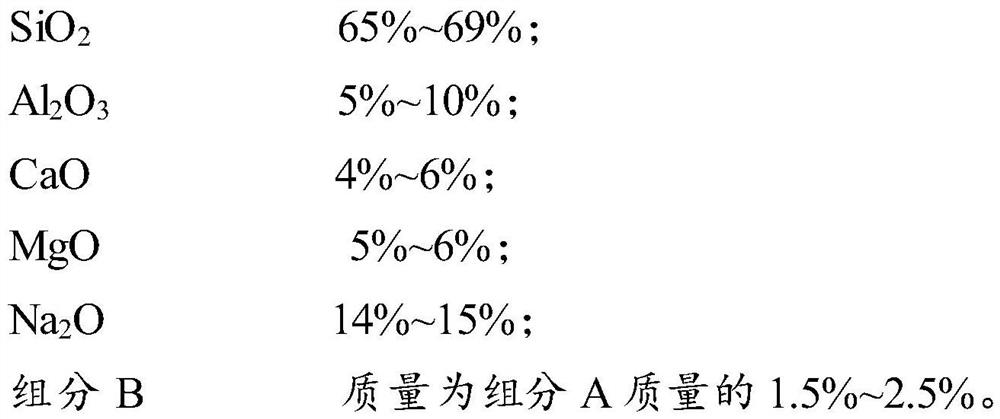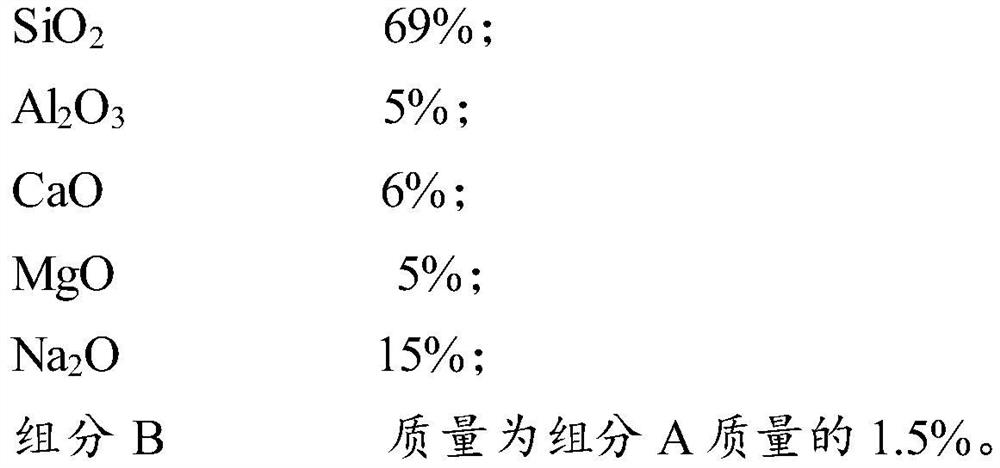Alkali aluminosilicate glass with high elastic modulus and preparation method thereof
A technology of silicate glass with high elasticity, which is applied in glass manufacturing equipment, glass tempering, glass molding, etc., and can solve problems such as poor elastic modulus of glass
- Summary
- Abstract
- Description
- Claims
- Application Information
AI Technical Summary
Problems solved by technology
Method used
Image
Examples
preparation example Construction
[0063] The present invention also provides a method for preparing the high elastic modulus alkali aluminosilicate glass described in the above technical solution, comprising the following steps:
[0064] a) Quartz sand, alumina, dolomite, magnesia, soda ash and LaCl 3 ·7H 2 O mixed to obtain a mixture;
[0065] b) heating and melting the mixture to obtain molten glass;
[0066] c) After pouring the molten glass into a mold for molding, annealing is performed to obtain glass.
[0067] Regarding step a):
[0068] The quartz sand, alumina, dolomite, magnesia, soda ash and LaCl 3 ·7H 2 O respectively corresponds to SiO in the glass 2 、Al 2 o 3 , CaO, MgO, Na 2 O, La 2 o 3 The constituents, ie the respective oxide constituents, are introduced by starting materials of the form described above. The amount of the above-mentioned raw materials is based on the composition ratio of the corresponding oxides in the target glass, that is, according to the composition of the targ...
Embodiment 1
[0078] 1. Glass composition:
[0079] Component A:
[0080]
[0081] 2. Preparation of glass
[0082] S1. Combine quartz sand, alumina, dolomite, magnesia, soda ash and LaCl 3 ·7H 2 O mixed to obtain a mixture;
[0083] Wherein, the feeding ratio of each raw material mentioned above is based on the ratio of each oxide in the glass product.
[0084] S2. Heat and melt the above mixture at 1550° C. for 5 hours to obtain molten glass.
[0085] S4. After pouring the molten glass into a mold for molding, anneal at 580° C. for 3 hours, and cool to room temperature to obtain glass.
[0086] 3. Performance test
[0087] The following performance tests were carried out on the obtained glass samples:
[0088] (1) After cutting the obtained glass, measure the modulus of elasticity, see Table 1 for the test results.
[0089] (2) After the obtained glass is chemically strengthened and further processed, the strengthening performance is tested:
[0090] Put cut glass into KNO 3 ...
Embodiment 2
[0093] 1. Glass composition:
[0094] Component A:
[0095]
[0096] 2. Preparation of glass
[0097] S1. Combine quartz sand, alumina, dolomite, magnesia, soda ash and LaCl 3 ·7H 2 O mixed to obtain a mixture;
[0098] Wherein, the feeding ratio of each raw material mentioned above is based on the ratio of each oxide in the glass product.
[0099] S2. Heat and melt the above mixture at 1550° C. for 5 hours to obtain molten glass.
[0100] S4. After pouring the molten glass into a mold for molding, anneal at 580° C. for 3 hours, and cool to room temperature to obtain glass.
[0101] 3. Performance test
[0102] Each performance test was carried out according to the test method of Example 1, and the test results are shown in Table 1.
PUM
| Property | Measurement | Unit |
|---|---|---|
| Elastic modulus | aaaaa | aaaaa |
| Surface compressive stress | aaaaa | aaaaa |
| Depth of stress layer | aaaaa | aaaaa |
Abstract
Description
Claims
Application Information
 Login to View More
Login to View More - R&D
- Intellectual Property
- Life Sciences
- Materials
- Tech Scout
- Unparalleled Data Quality
- Higher Quality Content
- 60% Fewer Hallucinations
Browse by: Latest US Patents, China's latest patents, Technical Efficacy Thesaurus, Application Domain, Technology Topic, Popular Technical Reports.
© 2025 PatSnap. All rights reserved.Legal|Privacy policy|Modern Slavery Act Transparency Statement|Sitemap|About US| Contact US: help@patsnap.com



